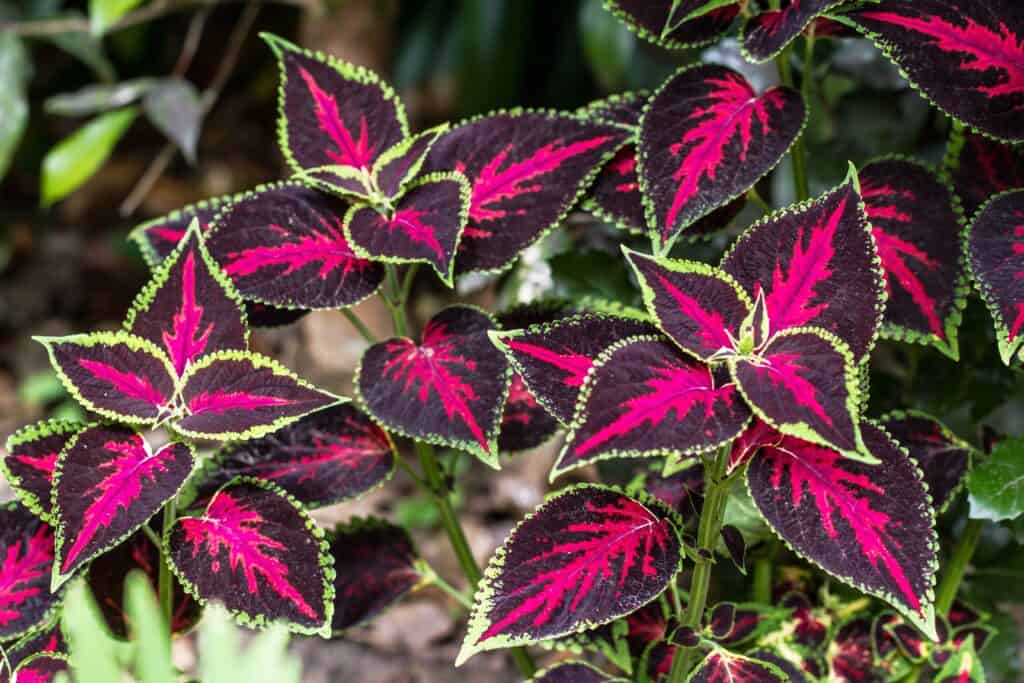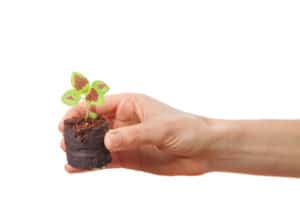The coleus plant is an excellent choice if you’re looking to add a touch of brightness and color to your garden. One thing that sets this foliage plant apart is its incredible number of varieties and colors.
Thanks to its versatility and flexibility, coleus is making a spectacular comeback in the modern garden, and more and more people are choosing it to bring that much-needed touch of distinction. In addition, many of its properties can be modified depending on how it is planted, creating a wealth of exciting variations for any garden.
This article will cover everything related to coleus leaves’ color so you can fully understand what affects it and how to get the perfect color for your garden. Let’s begin!

This ‘Wizard Jade’ coleus features an impressive yellow/green contrast on its leaves.
©Gurcharan Singh/Shutterstock.com
Coleus Leaves Color Varieties
Coleus, scientifically known as Coleus scutellarioides, has dozens of varieties. Each displays different patterns and colors that will add striking contrast to your garden or home.
Below we list some of the most exciting and vibrant coleus varieties so you’ll know what to look for if you need a specific color in your plant collection.
| Variety Name | Color | Comments |
|---|---|---|
| ‘Watermelon’ | Pink and Green | One of the most popular varieties and a beautiful combination of colors! |
| ‘Fishnet’ | Dark Purple | Ideal for a more gloomy, dramatic look |
| ‘Limelight’ | Lime-Green | Classic color that combines easily with other plants |
| ‘Alabama’ | Yellow and Pink | Also called ‘Alabama Sunset,’ this variety brings incredible vibrancy to your garden |
| ‘Picture Perfect Salmon Pink’ | Green, Salmon, and Pink | Its pastel tones belong to a painting! |
| ‘Big Red Judy’ | Red | This variety grows well in full shade or full sun |
| ‘Rustic Orange’ | Orange and Red | It features a yellow-green border with intense center colors |
| ‘Super-Fine Rainbow Festive Dance’ | Chocolate Brown | Useful for both garden beds and containers |
| ‘Henna’ | Red and Brown | This variety features a really distinctive tone and texture, perfect for adding variety to a pot |
What Determines Coleus Leaves’ Colors?
Essentially, the most determining element for a coleus variety to obtain a specific shade or color is its exposure to sunlight. Many gardening enthusiasts and even scientists have conducted various experiments to test what processes are set in motion when a coleus plant receives sunlight.
The scientific explanation is that sunlight increases certain critical coleus components, such as anthocyanin, and reduces others, such as chlorophyll, causing color changes. However, not all sunlight is the same. The colors are usually more pronounced and vivid if you place coleus in the bright, indirect sun. On the other hand, their colors will fade if you put them in full sun for many hours. Full sun can even burn the leaves in summer, so be careful.

The different varieties of coleus show off an impressive selection of colors, such as this ‘Chocolate Covered Cherry’ coleus.
©Dafinka/Shutterstock.com
Nevertheless, coleus that grows directly in full sun will develop more pigmentation for protection, resulting in powerful and intense colors. Of course, the sun in each region is different and is an essential variable in plant growth.
Still, sunlight is not the only explanation. The place where coleus is planted plays a significant role in its color, texture, and overall health. Many users report color changes depending on the soil or container used and its fertilization.
Why Is My Coleus Losing Its Color?
If you feel that your coleus does not look as radiant as usual, it may be due to various reasons. As mentioned before, the sun is a crucial factor and one which we must have a great deal of respect for. However, assuming that more sun means more color is dangerous and wrong.
One of the reasons your coleus may be losing color is overexposure to sunlight. Just as sunlight produces chemical processes that benefit the plant, it can also give the coleus excessive amounts of heat that result in sunburn. If your plant gets sunburned, its colors will fade and turn yellow and droop. To prevent this from happening, keep your coleus away from direct sunlight. Instead, find a place where they can receive indirect sunlight, such as by a window.
Another cause of your coleus leaves losing color may be underwatering. Like many other houseplants, coleus suffers greatly from dry soil. When they are dehydrated, their leaves begin to lose color and wilt.
Other causes why your coleus is losing color include:
- Overwatering
- Temperature stress
- Lack of potting soil
- Overfeeding fertilizers
Keeping Coleus Colors
You’ve already learned what you should do to keep your coleus healthy, but what are the things you should do to keep its colors in their best possible shape?
For a coleus plant to maintain bright colors, it is essential that it receives a considerable amount of light. As mentioned, avoid leaving it in direct sunlight for long periods of time and ensure it gets as much indirect light as possible during the day. Coleus also needs to be kept at a temperature of 60ºF or higher.
Also, keeping it in rich soil will favor its growth and the intensity of its colors. You should aim for soil rich in loam and sand with a touch of manure if you want your coleus to show vivid colors.
By following these steps, you should have no problem keeping the colors of your coleus intense and bright. If your coleus has been potted for some time, some nitrogen-rich fertilizer will definitely help it grow strong and healthy.
Want to learn more about this amazing plant? Check out our complete guide to the coleus here.
Up Next:
The photo featured at the top of this post is © Irina Kononova/Shutterstock.com
Sources
- The Girl With a Shovel, Available here: https://www.thegirlwithashovel.com/coleus-varieties-bring-color-to-shade-garden/
- Gardeners Point, Available here: https://gardenerspoint.com/coleus-losing-color/
- Pubmed / National Institutes for Health, Available here: https://pubmed.ncbi.nlm.nih.gov/19631554/
- Sunday Gardener, Available here: https://www.sundaygardener.net/taking-care-of-coleus-plants/
- Balcony Garden Web, Available here: https://balconygardenweb.com/best-coleus-varieties-different-types-of-plants/
Thank you for reading! Have some feedback for us? Contact the AZ Animals editorial team.






